|
 
COVER STORY | IN
THE NEWS | DIRT
TALK OF THE TABLE | THE HUM | CALENDAR
August 24, 2006
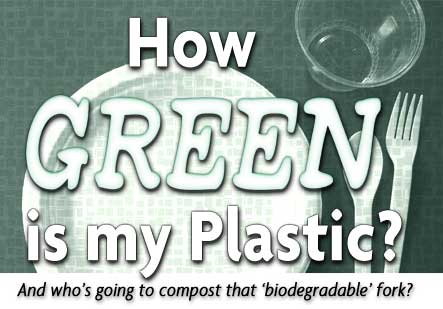
story and photos by BOB DORAN
THE FORK MOVED ALL
ON ITS OWN. Not much, just a slight twist, but it definitely
moved. It was the summer of 2004 and I was standing in front
of the Rasta Pasta booth at Reggae on the River, eating a hot
dish of pesto. I'd left the fork stuck in the hot food while
talking with a friend. When I pulled it from the pasta I found
that the tines were warped into a claw shape. My plastic utensil
had melted from the heat of the pasta pesto.
I learned the reason why from the Whitethorn School
folks running the pasta booth: The utensils were biodegradable,
made from corn. This was explained further when I took the plate
and fork to the nearby complex of garbage cans for proper disposal.
A smiling woman sat on a stool amid the barrels
and bags dressed in rolled up jeans and a grey Reggae T-shirt
with bold letters on the back identifying her as part of the
recycling crew. Her job was to direct festivalgoers regarding
the proper disposal of their waste: cans here, plastic bottles
and cups there, glass in another barrel and so on.
She explained that the large bag marked "plates
and utensils" was destined for composting, one part of a
plan to move toward a "greener" festival. While garbage
duty was not the most glamorous job at Reggae, she was happy
to be playing a small part in making the event waste-free and
thus more ecologically sound.
aka PLA
The fork I used that day and the cups used to serve
beer and soda were made from a plastic resin, polylactic acid,
aka PLA, a 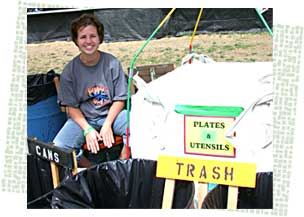 material most often
made from corn but also using other plant starches including
potatoes and wheat. material most often
made from corn but also using other plant starches including
potatoes and wheat.
Just about anyone you ask will tell you that bio-based
PLA plastics sound like a great idea. With awareness about the
relationship between petrochemicals and greenhouses gases at
an all time high (along with the cost of gasoline), people see
this new plastic derived from renewable resources as an attractive
alternative to our dependence on oil.
Add in the fact that we are getting buried by an
avalanche of plastic containers used to carry and hold this,
that and the other thing. Around 25 percent of the material in
our landfills is plastic.
The notion that bio-plastic is "biodegradable"
would also seem to be quite a plus. The people who make the stuff
certainly seem to think so. The word is embossed on the handles
of the forks and spoons used at Reggae this year.
The use of corn plastic has grown by leaps and
bounds since I first heard about it. Last year NatureWorks, a
major player in the industry (and the company that makes the
cups used at Reggae) signed a deal to supply Wal-Mart with clear
plastic containers for produce.
In a press release Wal-Mart noted that PLA plastic
will be used for 100 million containers per year and bragged
that, "with this change to packaging made from corn we will
save the equivalent of 800,000 gallons of gasoline and reduce
more than 11 million lbs. of green house gas emissions from polluting
our environment." They also pointed to PLA's "ability
to provide a price stable product as the price of oil needed
to produce conventional packaging keeps climbing higher and higher."
Could there be any downside to this picture of
an eco-groovy plastic future? A closer look into the world of
corn plastic shows that there are problems yet to be resolved.
One is a perception problem faced by the marketing
departments for corn/chemical corporations like Cargill Dow LLC,
owners of the NatureWorks brand. Targeting the ecologically-minded
can be tricky since such consumers tend to distrust mega-corporations,
particularly those who are turning broad swathes of the country
into huge factory farms covered with a genetically-engineered
mono-crop like corn.
Then there's that word -- biodegradable -- embossed
on the fork handle. What exactly does it mean? We'll get to that,
but first let's go back to Reggae.
"A Green Event"
Earlier this month, just before this year's festival
I tracked down Patty McGuire, crew leader for the food operation
feeding all Reggae volunteers. She orders "thousands of
dollars worth" of plasticware to supply the volunteers and
staff kitchens, and the dozens of nonprofit booths. Most of what
she orders comes from a company called Cereplast.
When she mentioned that "all the plastic forks,
spoons and cups are biodegradable/compostable," I asked
what that meant to her. How exactly is the stuff composted? Admitting
that she was unsure, she said, "I don't really know where
it goes after it leaves my kitchen."
In a hurry to get back to preparations for the
festival, McGuire offered the number for Cereplast for further
details.
The number led to Cereplast Vice President of Marketing
Russell Wegner, a bioplastics true believer who told me, "We're
in the resin business," as he launched into a discussion
of the potential for PLA-plastic as a substitute for almost any
type of conventional plastic -- at least within limits.
The main limit: It melts when it gets to a certain
temperature, a fact that is crucial in making it compostable.
Cereplast currently makes plastics that will tolerate up to 155
degrees. "For something to be truly biodegradable, reaching
higher temperatures tolerances is a challenge," said Wegner.
"The composters want it to break down; the consumer wants
it to hold up."
But what if the stuff gets sent to the dump instead
of a compost operation? He concedes that, "depending on
the temperature of the landfill, it could sit for a long time,"
but, he added, even if the product is not composted, "You're
still buying something that's sustainable and bio-based that
uses a renewable source versus fossil fuels."
This year's Reggae on the River was different from
years past. For one thing, the festival moved upriver to a new
site allowing more room for more people. It's safe to assume
more people meant more to recycle and more trash.
The recycling/trash system was stripped down this
year compared to the 2004 set-up. There were no garbage monitors
and no bags for utensils and leftovers, just barrels for plastic,
glass, cans and trash.
An onstage announcer declared, "This is a
green event. Virtually everything is biodegradable, compostable
or recyclable," but there was no sign that the thousands
of forks, spoons and cups coming from the food court were being
collected for composting. A look into the cans showed that the
forks and spoons went into the trashcans; the clear PLA-plastic
cups were thrown in the "plastic" barrel where they
mixed with recyclable petro-plastic water bottles.
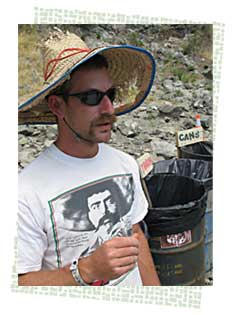 Where
did the compost go? Where
did the compost go?
What happened to the compost collected in 2004?
I got a hint when I ran into Ian Sigman (left) of Mattole
River Organic Farms on Bob Marley Boulevard, the main road through
the new Reggae. Sigman was leading a recycling crew, a team of
brown-shirted waste handlers who poured barrels full of bottles,
cans, plastic and trash into large plastic bags to be hauled
off on his biodiesel farm truck.
He told me of his own interest in composting Reggae
green waste. Up until 2004, he had simply amassed the vegetable
trim from the various kitchens and hauled it back to his farm
for composting. Then, as he put it, a guy named Steve Salzman
"weaseled his way in."
Salzman (no relation to political consultant Richard
Salzman) had to inform the composting crew that "some kind
of permit was needed for food waste." While Sigman was all
for "guerilla composting," Salzman had a fairly elaborate
plan for an onsite system.
Salzman is a waste management specialist who works
for Winzler and Kelly. Calling from the engineering firm's Eureka
office he explained that he'd volunteered his time in 2004 to
come up with a proposal to deal with more than just kitchen scraps,
He designed an onsite composting operation "to try to capture
the compostable paper and post-consumer scraps. And P.B. and
his crew had already ordered the compostable plastic that year
and were making all the vendors use it."
P.B. would be Paul "P.B." Bassis, one
of the main players in People Productions, producers of Reggae
-- at least until recently, when he split off to form his own
company, Infinite Entertainment. Among Infinite's clients is
Julia "Butterfly" Hill, the world-renowned tree-sitter/environmental
activist, who, post-Luna, founded the Circle of Life Foundation.
One of Circle of Life's projects was a series of events called
We the Planet, zero-waste gatherings demonstrating the potential
for greener festivals.
W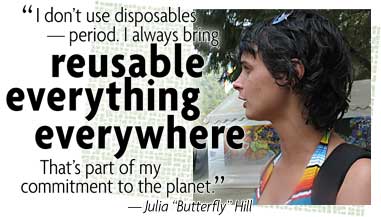 hen
I spoke with Hill at this year's Reggae and later after she was
back in the foundation office in Oakland, she allowed that she
doesn't think much of disposable plastic forks and spoons, cups
and to-go containers in general, not even those made from corn
plastic since she sees the current methods of corn production
as "out of balance" with nature. hen
I spoke with Hill at this year's Reggae and later after she was
back in the foundation office in Oakland, she allowed that she
doesn't think much of disposable plastic forks and spoons, cups
and to-go containers in general, not even those made from corn
plastic since she sees the current methods of corn production
as "out of balance" with nature.
She asks rhetorically, "Are we going to use
the toxic petroleum product that's going to go out into a landfill
and slowly and toxically break down? Or are we going to use a
plastic that comes from corn that's genetically modified and
coming from huge corporations that have no interest in taking
care of the planet or the people on it?"
Her personal solution: "I don't use disposables
-- period. I always bring reusable everything everywhere I go.
That's part of my commitment to the planet."
Circle of Life also serves as a clearinghouse for
eco-groovy festival methods through their Greening Events Guide,
which recommends many of the things instituted in the Reggae
2004 composting program: monitors at each recycling station,
onsite composting and the use of compostables, at least where
appropriate.
Salzman said he understood that by implementing
the Reggae composting plan he was "stepping on some toes,"
but he moved forward. After the food waste was gathered along
with the compostable paper, cups and utensils, it was put in
a large mixing vessel brought in by Andrew Jolin of Mad River
Compost, the company that handles green waste composting for
residents of Arcata. An elaborate aeration device was used to
blow air into what is called a "static aerated pile,"
which, said Salzman, "made it get really hot really fast,"
a key factor when it comes to breaking down PLA-plastic.
"We had pretty good success overall,"
he added. "We diverted around 50-100 yards of waste, I can't
tell you how many tons."
The corn plastic? Last time Salzman checked, "forks
and the cups and plates shriveled up and got brittle. But they
did not melt into the pile." Digging into the remains months
later he found, "distorted, weird little pieces of plastic
that were still recognizable." He noted that a mechanical
turner would break up the pieces facilitating dispersal. He was
not sure what ultimately happened to the 2004 compost, if it
was spread around the concert location or taken to some farm.
Carolyn Hawkins, solid waste LEA (local enforcement
agency) program manager for Humboldt County Division of Environmental
Health should know since the experimental composting program
was allowed under a research permit. What happened to the compost?
She's not sure either since, "They never submitted the conclusions
they were supposed to."
Andrew Dillon, top dog in Reggae recycling, knows.
The stuff ended up in the community park in Garberville. Noting
that the 2004 process was "really expensive," he explained
another reason the experiment was not repeated. The Dimmicks,
owners of the new site for Reggae, do not want onsite composting.
This year's kitchen waste? "It went to the landfill, but
it's not bad for the landfill -- it will decompose."
As to this year's corn plastic forks and spoons,
they ended up in the landfill too. The NatureWorks plastic cups
are another story.
Grocers and recyclers
I ran into Phil Ricord, owner of Wildberries Marketplace,
lounging under one of the shade tents at Reggae finishing off
a beer, which as he pointed out, was served in the same sort
of NatureWorks cup used in the smoothie bar at his store. Noting
that he likes i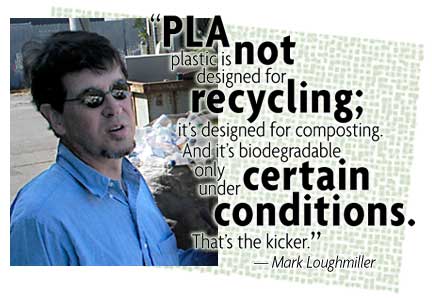 t
that "the cups go back into the food chain," he turned
his over and showed me what seemed to be a recycling symbol on
the bottom: a triangle of arrows with the number 7 in the middle.
What does it mean? Neither of us knew. t
that "the cups go back into the food chain," he turned
his over and showed me what seemed to be a recycling symbol on
the bottom: a triangle of arrows with the number 7 in the middle.
What does it mean? Neither of us knew.
Back in Arcata I stopped by the office of Mark
Loughmiller executive director of the Arcata Recycling Center,
something of a plastics expert. He explained that the "7"
is a resin identification number denoting "other."
"That's where the recycling industry is having
an issue" with the PLA-plastic manufacturers, he contended.
He launched into a tangled history of the resin identification
system. Reduced to basics it comes down this: The triangle of
arrows does not necessarily mean the plastic can or will be reused.
No. 1 and No. 2 plastics are pretty much the only grades that
are effectively recycled. Nos. 3-7 are typically lumped together
and shipped out to plastics handlers who send them to China and
a fate unknown. (See Journal cover story June 5, 2003,
"The Problem With Plastics.")
Loughmiller thinks adding PLA in the "other"
category just confuses the consumer who falsely assumes the material
is recyclable. It is not. Once it shows up at the recycling center,
said Loughmiller, "It's trash."
Loughmiller sits on the board of directors of the
North Coast Co-ops. His advice to the Co-op: "Go with the
cheapest thing. The PLA sells at a premium, and the fact is,
the [PET] containers they're using now are recyclable. PLA plastic
is not designed for recycling; it's designed for composting.
And it's biodegradable only under certain conditions. That's
the kicker.
"They're hanging their hat on the public's
environmental desires, knowing the public is not really educated
about all of the side issues. All most people care is, `Oh, petroleum
is bad; there's an oil shortage. We need an alternative, so let's
buy this package.' When it comes down to it, it's all marketing.
You've got a company with a product that's an alternative to
petroleum, at least somewhat. They're marketing that point, but
ignoring things like the energy inputs."
"We haven't adopted corn plastic," said
Len Mayer, general manager of the Co-op. "Eco-friendly plastic
or paper is a half step. It would be great if it was a solution,
but there are still some issues. Ultimately the best thing is
for people to reuse containers, for people to bring their own
in."
Loughmiller's other concern is with the contamination
factor. Since PLA can look almost identical to recyclable plastics,
most consumers will not recognize it and will add it to their
other recycling. If a bundle sent off for processing is 2 percent
contaminant, the load will be rejected.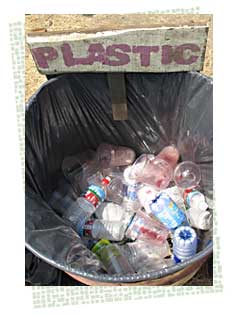
If you go to the Cereplast or NatureWorks website,
you'll find that there's usually an asterisk next to the word
"biodegradable." Their definition is based on guidelines
set by the Biodegradable Products Institute (BPI). They'll tell
you the biopolymers will degrade in a certified "controlled
composting environment," a municipal/ industrial facility
with a digester that meets their standards. They even supply
a map showing the nearest such facility in your area. There are
none in Humboldt County.
Those plastic cups at Reggae? Since most people
saw them as "plastic" they are currently part of the
recycling material headed for Eel River Disposal & Resource
Recovery in Fortuna, the company that handles the recycled glass
and plastic for the festival. When I spoke with company president
Harry Harden last week, he had not yet picked up the Reggae recycling
and seemed unaware that the plastic collection could be a co-mingling
of No. 1 petro-plastic bottles and No. 7 corn plastic cups, but
he's not surprised.
Right: Comingled No. 1 plastic bottles
and corn plastic cups at Reggae 2006.
To the consumer, "Plastic is plastic,"
he told me. "They'll come in here and throw laundry baskets
in with the recycling.
"If [the plastics from Reggae are] not too
badly contaminated I'll just bail it altogether," he said,
"but if it's heavily contaminated, I'll have to run it across
my sorting belt and we'll hand pick it," separating the
No. 7 cups.
Harden said he would probably add the corn-plastic
cups to his "film-plastic," a mix that includes grocery
bags and the like. "We send the film plastic to San Leandro
and they process it to mix it with wood chips and make lumber
with it, decking."
According to Mark Loughmiller, the co-mingled corn
plastic will have to be removed from the recycling stream at
some point. If Harden sends it to San Leandro, it will happen
there. Putting it bluntly, Loughmiller said PLA is "trash,"
destined for the landfill.
"The Trex decking he referred is generally
made exclusively from plastic film. PLA plastic would be a contaminant.
The industry has a mechanism to separate the contaminants, but
once they do, it's garbage for them.
"My attitude is to be up front with the residents,
to tell them, `This is garbage' and make them throw it away rather
than paying the freight to send it elsewhere."
Loughmiller noted that the PLA industry made a
presentation at a recent national recycling conference and suggested
that a system be put in place so that recyclers could accept
PLA plastic. "They're argument was, `Yes it is a contaminant,
but if you collect it and send it to us, we will make sure it's
composted.' But we're not going to collect it and spend thousands
of dollars to truck it to them."
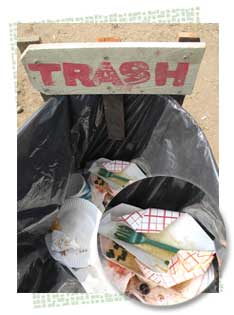 Nevertheless, when
it comes to the bottom line, Loughmiller does not seem too worried
about the impact of corn plastic because it's not as toxic as
much of the material that goes into the landfill. Nevertheless, when
it comes to the bottom line, Loughmiller does not seem too worried
about the impact of corn plastic because it's not as toxic as
much of the material that goes into the landfill.
"It has almost no weight; you can dispose
of it and it's not going to hurt a damn thing. I'd rather spend
our limited resources on getting batteries out of the waste stream
or hazardous household chemicals."
Left: Reggae 2006, biodegradable fork in the
trash.
Organic Planet
Simply from the name of the local festival coming
up in Eureka this Saturday, the Organic Planet Festival, you
have to assume the organizers are striving for sustainability.
This is the second such event sponsored by Californians for Alternatives
to Toxic Sprays "celebrating a natural and non-toxic world."
Said Patty Clary executive director of CATS, "We've
been going through hell trying to get our waste stream down.
We've been trying to do the right thing, but there are controversies
in everything you do."
For example, last year's festival followed one
of Julia Butterfly's waste reduction tips by asking people to
bring their own foodware.
"We told people to bring their own plate for
the world's largest organic salad," said Clary. "We
found out you can't do that."
After the festival the county health department
called Eureka Natural Foods, the primary sponsor of the big salad,
to let them know that the possibility of contamination made the
BYO suggestion a no-no.
Karen Sherman is the volunteer in charge of procurement
of supplies for Saturday's festival. She also works for the City
of Arcata's environmental services department, a job that includes
looking at trash generated during public events like those held
regularly on the Arcata Plaza.
"There's a new law that states [events] over
2,000 people must show what they're doing to reduce waste. So
we've been talking with event coordinators asking them to make
plans as to what they're going to do: Whether they're going to
try to go with compostable cups and dishes or what other kind
of materials they'll have, whether they'll be recycling."
Asked where the material might be composted, Sherman
suggested, "either backyard composting or at a commercial
facility," admitting she was not sure about the logistics
or about the laws regulating composting.
For the Organic Planet Festival she settled on
compostables purchased through a local company, Gess Environmental.
She says she tried to minimize use of corn PLA, "because
of the GMO-related controversy around using corn. For the most
part we went with bagasse, a material made from sugar cane. We
went with the SpudWare for our forks and spoons thus limiting
the PLA to our wine and beer."
She has arranged for volunteers like those used
at Reggae 2004 who will direct people on what item goes in which
container. "I don't want the beer and wine cups to get into
the recycling bins," she said.
While she was aware of the potential for corn plastic
contamination, she did not really know the fate of the material
used at the festival. From talking with Christine Jolin of Gess
Environmental, she assumed it would be composted. Since Christine's
husband, Andrew Jolin, is the composter who runs Mad River Compost
(and the same guy who aided in the Reggae operation), she figured
it would be composted there. It won't. It's not that he couldn't
-- legally he can't.
As Loughmiller explained, "Andrew, when he
says he can do it, he has to be speaking technically. Legally
he cannot recycle post-consumer food waste. That's one of his
big issues. He can collect the waste from prep kitchens, but
not the food left on the plate that a customer has touched. It's
a health code issue."
Hawkins, the environmental health enforcer whose
department oversees Jolin's compost operation concurred, "That
is not waste that's allowed at the [Mad River] facility under
his current operation agreement. They don't have a permit to
do food."
The composter
Andrew Jolin spent much of the last 10 years collecting
food waste, composting it and using it on his worm farm, then
the law changed and he is not allowed to do so any more. He's
still intent on seeking out a viable option for that part of
the waste stream, and for bioplastics, but says the laws make
it quite complicated.
"Because of changes in the rules, we've had
to discontinue picking up [the PLA plastic] from Wildberries
and others we were dealing with," he said. "The problem
is that we don't have an established food waste program in the
county, and because of the [small] volume we probably won't."
Jolin said he's been talking to a number of local
businesses: Robert Goodman Winery, Footprint Biodiesel, HSU and
others about collecting their bio-waste.
"We are preparing to a do a pilot project
with the city of Eureka, Arcata and HSU collecting food waste.
The Organic Planet Festival will be an advance part of that.
We'll be collecting their food waste [and compostables] to characterize
it: check for contaminants, see what volume you have."
And once it's analyzed? "It will go to the
landfill."
Jolin is obviously passionate about the importance
of composting and the potential for bioplastics. He worries that
his plans will be misunderstood.
"This is all new, cutting-edge stuff,"
he tells me as he calls for the third time in the space of an
hour. "I hate to see red flags go up on biodegradables.
The Co-op has been questioning whether they should go over. One
of the board members was saying it makes it hard on recycling
because it gets mixed in. It's not really [a contaminant for
recycling]. Down in the Bay Area the oil industry got together
with the plastic recyclers making false claims against it. With
the equipment they already use for sorting PET, you can easily
remove the PLA.
"Let's get down to what's really important
here: We can sit by and be like Ford and GM are with the hybrid
[vehicles] and be way behind, or we can embrace this new technology
and work on perfecting it. But if we just sit around and criticize
it, it just won't happen. The other option is more polystyrene,
more oil-based PET and other oil-based plastics, most of which
are not recycled and end up in landfill. Let's face it: It's
made from oil and that's the scourge of our civilization right
now. [Bioplastic] is not a perfected technology, but companies
like Cereplast and NatureWorks are putting a lot into it. No,
it's not perfect, but it's going in the right direction."
Post-script
After I spoke with Patty Clary from CATS telling
her a little bit about what I'd learned about this complex issue
she sent me an e-mail. "So, in your article, is CATS to
be made out to look like hypocrites or dupes for buying compostable
plastic?" she asked. "Actually, I feel pretty good
about what we're attempting overall with our festival, and I'm
not naïve enough to think that trying to do something won't
stir things up...."
I wrote her back to say I didn't really think of
anyone I talked with as being hypocritical on the subject of
bioplastics. Most consumers seem woefully under-informed, but
it's heartening that they are willing to try to do the right
thing. The harsh reality is this: Even if your plastic is greener,
it's still going to end up at the dump. As Harry Harden so eloquently
put it, "Plastic is plastic."
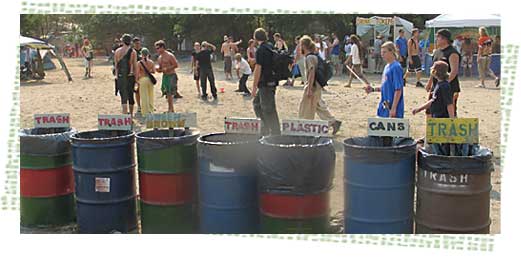
Above:Trash and recycling at Reggae on the River.
TOP
COVER STORY | IN
THE NEWS | DIRT
TALK OF THE TABLE | THE HUM | CALENDAR
Comments? Write a
letter!

© Copyright 2006, North Coast Journal,
Inc.
|


 material most often
made from corn but also using other plant starches including
potatoes and wheat.
material most often
made from corn but also using other plant starches including
potatoes and wheat. Where
did the compost go?
Where
did the compost go? hen
I spoke with Hill at this year's Reggae and later after she was
back in the foundation office in Oakland, she allowed that she
doesn't think much of disposable plastic forks and spoons, cups
and to-go containers in general, not even those made from corn
plastic since she sees the current methods of corn production
as "out of balance" with nature.
hen
I spoke with Hill at this year's Reggae and later after she was
back in the foundation office in Oakland, she allowed that she
doesn't think much of disposable plastic forks and spoons, cups
and to-go containers in general, not even those made from corn
plastic since she sees the current methods of corn production
as "out of balance" with nature. t
that "the cups go back into the food chain," he turned
his over and showed me what seemed to be a recycling symbol on
the bottom: a triangle of arrows with the number 7 in the middle.
What does it mean? Neither of us knew.
t
that "the cups go back into the food chain," he turned
his over and showed me what seemed to be a recycling symbol on
the bottom: a triangle of arrows with the number 7 in the middle.
What does it mean? Neither of us knew.
 Nevertheless, when
it comes to the bottom line, Loughmiller does not seem too worried
about the impact of corn plastic because it's not as toxic as
much of the material that goes into the landfill.
Nevertheless, when
it comes to the bottom line, Loughmiller does not seem too worried
about the impact of corn plastic because it's not as toxic as
much of the material that goes into the landfill.